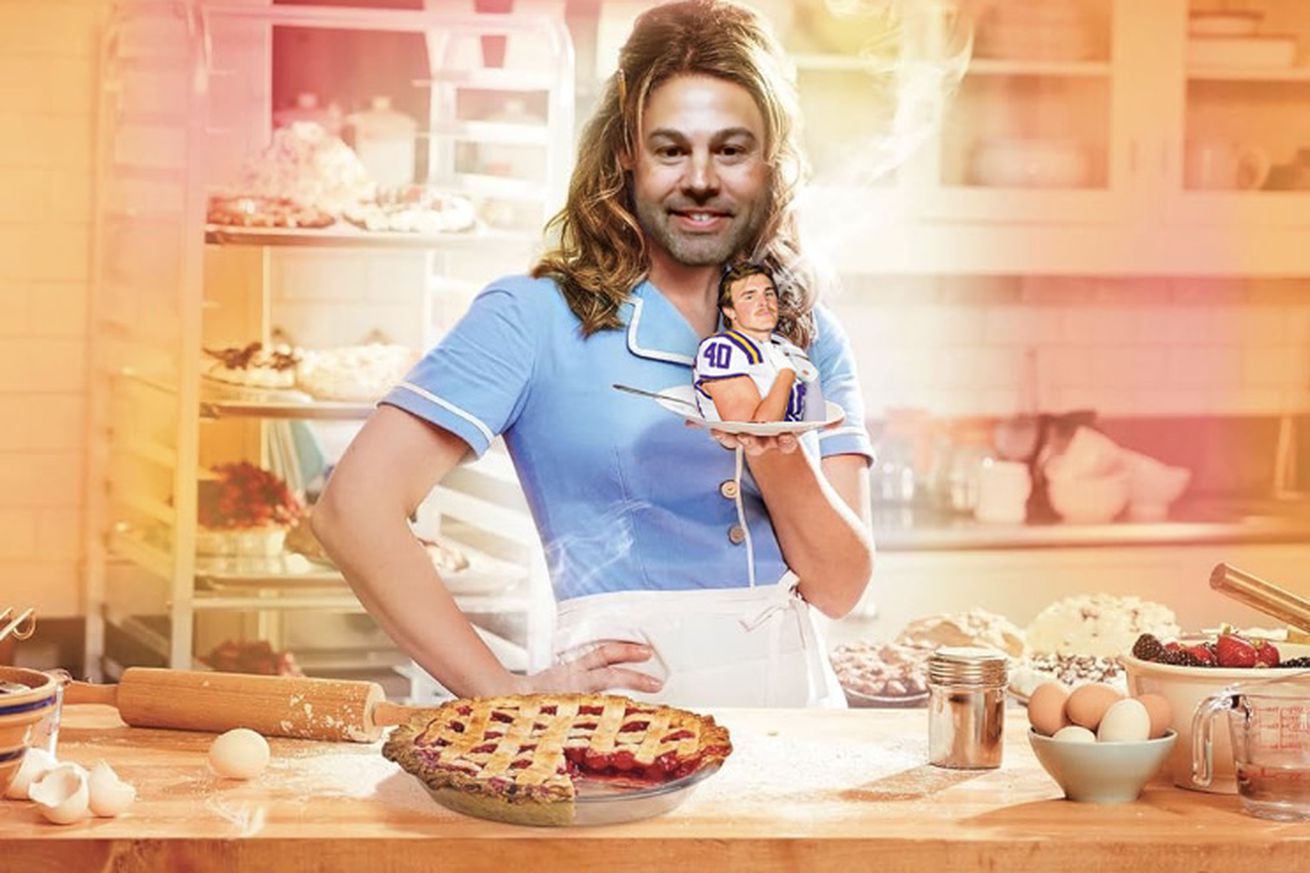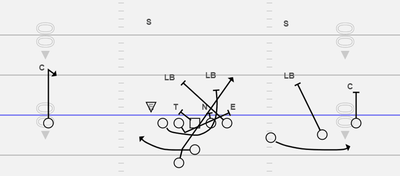
What Baking Can Do
Ole Miss’ offense has been one of the best in the country since Lane Kiffin stepped onto Oxford’s sorority row. The secret has always been a devastating interplay between the run game and the RPO/PA gadgetry that creates explosive plays while keeping training wheels on the QB. The downside, however, is that the passing game is pretty predetermined and they don’t run a whole lot of different stuff. If you take away a certain handful of things, you can make life tougher for them than they are willing to stomach. Their players are good, and the LSU defense isn’t talented enough to shut down an offense like this, but with a perfect gameplan and some heroic performances, you can slow them down enough to win. As their fans will claim, yes, Ole Miss stood a few missed opportunities on O from winning this game, but don’t let that convince you their offense played well, it struggled while their defense kept it close. Altogether, they averaged 5.5 yards per play and only 6.8 through the air.
Defending their offense is easy in concept but difficult in practice. If you can take away the seams, deep crossers with the post routes that run behind them, RPOs to the slot, dissuade free access hitches and fades to Harris, and fit their downhill run game at the same time, they have nothing. At that point, you can force them into a true dropback world that they are not comfortable with. Getting to that point is difficult, as you have to be specialized enough to target different offensive plays without being predictable enough for them to dial up counterpunches and dictate how you play defense. At some point, you will also have to be able to win at a disadvantage such as defending the run from light boxes, holding up in man-coverage, getting pressure with only 4 or 5, or a combination of all of the above.
On overview, Baker’s plan was first and foremost to use a handful of different/unpredictable 2-high coverages with tailored rules to take away their favorite pass plays both downfield and in the middle. To stop the run and get after the QB, LSU mixed in a ton of late rotations and blitzes by the Safeties and Nickels to get guys to the LOS. Behind that they played man-coverage, in fact virtually every time they sent 5 or more guys they played Cover-1 to avoid leaving too much space in the seams, as zone pressures can. Baker mixed in and out of these worlds while presenting the same basic 2-high shell more often than not and Ole Miss couldn’t key in on what they were going to do. For a predetermined offense, this is a serious problem. As I said earlier though, LSU would have to win at some kind of a disadvantage, and when they did play man coverage, they largely held up thanks to outstanding games from Ashton Stamps and Zy Alexander. They forced Ole Miss to be honest which, especially when they sent 5 and got Swinson into 1 v 1s, caused Jaxson Dart to short-circuit in the pocket and take sacks. With the overview taken care of, let’s get a bit more detailed with it.
Make it Work
They also do a good job covering it up. While it leaves you more vulnerable to big plays, the way LSU has their LBs trigger downhill takes the burden off the DL to control space.
The explosive runs have been ugly but this is *saving* LSU’s down-to-down defense. https://t.co/YA3IoOxQ85 pic.twitter.com/rHy28myviQ
— Max Toscano (@maxtoscano1) October 14, 2024
Nothing about this gameplan would work if LSU couldn’t stop the run down to down. Ole Miss builds everything around the run game and if they have it they will just keep running it. Last year they rushed for 317 yards on LSU, so you have to find a way to fit the run out of every coverage, whether the box is full or empty, that you carry that week. LSU breaks from most modern defenses in that they don’t seek to control gaps and maintain soundness, but create disruption. This is boom or bust, but this style has helped LSU manage its interior defensive line issues. As you can see in this clip, the DT gets washed down but the disruption created by Penn and Weeks’ downhill trigger stops the play. The lack of soundness and a true second level leads to explosives but the trade-off has been worth it, as 180 yards (on 42 carries) is quite a bit less than 317.
— MTFilmClips (@MTFilm) October 15, 2024
The linebackers have a hard job in this defense. Instead of staying back and reading things, they have to be ready to attack their primary gaps while still often being responsible for reading and tracking pullers. Here Weeks has to track the puller across the formation because his primary gap, the inside shoulder of the left-guard (A gap at the start of the play), moves. Because there is support outside. he is responsible for getting inside the G and making the play.
— MTFilmClips (@MTFilm) October 15, 2024
When you’re playing Ole Miss the first play you have to think about stopping on the ground is counter, specifically counter-read. To account for both the QB and the RB, LSU had the unblocked edge defender crash down hard on the frontside run while the inside linebacker away. That’s a pretty hard job for the linebacker and will often force him to beat a block to make the play. Ole Miss’ design is perfect but Weeks knifes under the crack to chase this down.

The Chief in the North

Weekly Spiral
There are a lot of ways to run this play, but the idea is counter one way with the edge unblocked and the option to keep out the back if he collapses behind the pullers. It’s tough to defend because you need numbers to match the pullers while having numbers backside to play the backside run option. Ole Miss later had some success with this play which is impossible to stop when blocked well but LSU did enough to keep it from being a problem.
— MTFilmClips (@MTFilm) October 15, 2024
— MTFilmClips (@MTFilm) October 15, 2024
As part of the run defense, you also have to find a way to deal with the RPO against a team that leans on them. Covering RPO routes while adequately fitting the run from 2-high alignments (alignments that LSU’s gameplan centered on), requires modification to your front but is very doable. Ole Miss, like most of your typical 11-personnel shotgun teams, runs a lot of their RPOs to the slot and the side of the RB. As a result, LSU often put their backside edge inside of the last guy on the LOS (either inside the TE or if there isn’t one, inside the T) while the 2nd level defender behind him is responsible for the perimeter (force defender). Because a run would need to wind all the way back to hit the backside perimeter, you don’t need immediate help on that edge. This allows that defender to stay at depth and cover the route while playing his gap late if he sees it handed off. As you can see above, Burns stays in the window for any slants or hitches while still being present in the run fit. In the second clip, Weeks is in a good position to rally to the screen.
Make it Easy
— MTFilmClips (@MTFilm) October 15, 2024
We’ll get to the meat of the gameplan in the passing game in a moment, but LSU needed to vary up its looks and find ways to exploit matchups on the edges to heat up the QB. The menu for pressuring Ole Miss with extra bodies is very limited but if you can do it effectively, there is a lot of return on your investment. You can’t all-out, 0 blitz them due to how good their WRs are and how spread out they play, and standard zone pressures are off the table because you can’t afford to leave air in the 2nd level of your coverage with how much they attack the seams. LSU was limited to sending 5 and playing Cover-1 (man-man everywhere with a free safety). This created easy wins and quick pressure for Swinson along the front, but the corners had to hold up against good players and to their credit, they mostly did it. Zy Alexander in particular gave up nothing and made several plays despite some tough asks.
Make it Clever, Craft it Into Pieces
— MTFilmClips (@MTFilm) October 16, 2024
Ole Miss’ entire passing game runs through seams and sails. If you can take away this area, you’re eliminating a lot of their offense. Whether through the PA game or straight dropback, they want to create and exploit space in the middle. They throw vertically to the outside guys too, which was addressed, but there isn’t a lot of diversity in how they target those guys. The guy you really have to cover is the guy who ends up inside.
— MTFilmClips (@MTFilm) October 16, 2024
With the bye-week, Baker installed a special coverage that he called when he wanted to bracket the seams and drive on anything inside. My best guess* at the rules of this coverage is diagrammed above and the responsibilities played out broadly as follows:
Corners: Man to Man on INITIAL number 1 (1st eligible receiver lined up from the sideline). Alignments vary between press and off. (I’m not sure if Alexander zoning off deep on that one play was him freelancing off the QB’s eyes or another rule).
Field Overhang (Nickel): Man to Man on INITIAL number 2 (2nd eligible from the sideline) with OUTSIDE LEVERAGE. Play him outside to cut off anything breaking out
Field Safety: Bracket FINAL number 2 (whoever ends up the 2nd receiver from the sideline during the play, the final inside of the 2 receivers). Cut off anything breaking in from inside position. If final number 2 breaks out, the outside leverage of the overhang takes care of that so you are free to go cover anything from the other side.
Boundary Overhang (WILL): Man to Man on INITIAL number 2 underneath, if he is vertical (runs past 5 yards), carry him downfield with underneath leverage.
Boundary Safety: Bracket INITIAL 2 vertically with WLB, if he does not go vertically, look to bracket number 1 from inside as he will likely become FINAL 2 (you can see this rule triggered here with Jardin Gilbert)
MIKE: Hug Rush RB. Man to Man on him if he releases, rush if he stays in.
*Note that this is general and there may be additional rules that I can’t pick up on without being there or talking to the staff.
— MTFilmClips (@MTFilm) October 15, 2024
LSU called this coverage a bunch of times with a lot of success, as Ole Miss failed to get much on the usual pass concepts they use to target these areas.
— MTFilmClips (@MTFilm) October 15, 2024
— MTFilmClips (@MTFilm) October 15, 2024
LSU also used cloud coverages (corner in the flat) with tailored rules to take away specific things underneath, provide support on vertical threats, and generally maintain 2-high safeties to cap their shot plays. As you see in the first clip, clouding these fast push routes by the RB allowed the overhang and LB to stay inside and cut off the in-breakers that often accompany them. In total, their back-end approach prevented Ole Miss from hitting much downfield which put them in tough spots and forced Dart to hold the ball and invite pressure. LSU isn’t talented enough to stop an offense like this right now, but they made life very hard and that won them this game.
